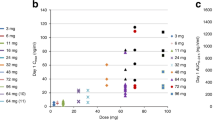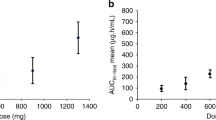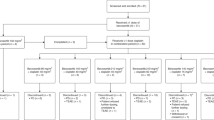Abstract
We performed a phase I and pharmacological study to determine the maximum tolerated dose (MTD) and dose-limiting toxicities (DLT) of a cytotoxic regimen of the novel topoisomerase I inhibitor topotecan in combination with the topoisomerase II inhibitor etoposide, and to investigate the clinical pharmacology of both compounds. Patients with advanced solid tumours were treated at 4-week intervals, receiving topotecan intravenously over 30 min on days 1-5 followed by etoposide given orally twice daily on days 6-12. Topotecan-etoposide dose levels were escalated from 0.5/20 to 1.0/20, 1.0/40, and 1.25/40 (mg m-2 day-1)/(mg bid). After encountering DLT, additional patients were treated at 3-week intervals with the topotecan dose decreased by one level to 1.0 mg m-2 and etoposide administration prolonged from 7 to 10 days to allow further dose intensification. Of 30 patients entered, 29 were assessable for toxicity in the first course and 24 for response. The DLT was neutropenia. At doses of topotecan-etoposide 1.25/40 (mg m-2)/(mg bid) two out of six patients developed neutropenia grade IV that lasted more than 7 days. Reduction of the treatment interval to 3 weeks and prolonging etoposide dosing to 10 days did not permit further dose intensification, as a time delay to retreatment owing to unrecovered bone marrow rapidly emerged as the DLT. Post-infusion total plasma levels of topotecan declined in a biphasic manner with a terminal half-life of 2.1 +/- 0.3 h. Total body clearance was 13.8 +/- 2.7 l h-1 m-2 with a steady-state volume of distribution of 36.7 +/- 6.2 l m-2. N-desmethyltopotecan, a metabolite of topotecan, was detectable in plasma and urine. Mean maximal concentrations ranged from 0.23 to 0.53 nmol l-1, and were reached at 3.4 +/- 1.0 h after infusion. Maximal etoposide plasma concentrations of 0.75 +/- 0.54 and 1.23 +/- 0.57 micromol l-1 were reached at 2.4 +/- 1.2 and 2.3 +/- 1.0 h after ingestion of 20 and 40 mg respectively. The topotecan area under the plasma concentration vs time curve (AUC) correlated with the percentage decrease in white blood cells (WBC) (r2 = 0.70) and absolute neutrophil count (ANC) (r2 = 0.65). A partial response was observed in a patient with metastatic ovarian carcinoma. A total of 64% of the patients had stable disease for at least 4 months. The recommended dose for use in phase II clinical trials is topotecan 1.0 mg m-2 on days 1-5 and etoposide 40 mg bid on days 6-12 every 4 weeks.
This is a preview of subscription content, access via your institution
Access options
Subscribe to this journal
Receive 24 print issues and online access
$259.00 per year
only $10.79 per issue
Buy this article
- Purchase on Springer Link
- Instant access to full article PDF
Prices may be subject to local taxes which are calculated during checkout
Similar content being viewed by others
Author information
Authors and Affiliations
Rights and permissions
About this article
Cite this article
Herben, V., ten Bokkel Huinink, W., Dubbelman, A. et al. Phase I and pharmacological study of sequential intravenous topotecan and oral etoposide. Br J Cancer 76, 1500–1508 (1997). https://doi.org/10.1038/bjc.1997.585
Issue Date:
DOI: https://doi.org/10.1038/bjc.1997.585
This article is cited by
-
Topotecan, cyclophosphamide, and etoposide (TCE) in the treatment of high-risk neuroblastoma. Results of a phase-II trial
Journal of Cancer Research and Clinical Oncology (2007)
-
Pharmacokinetically guided phase I trial of topotecan and etoposide phosphate in recurrent ovarian cancer
British Journal of Cancer (2005)
-
A phase I clinical trial of continual alternating etoposide and topotecan in refractory solid tumours
British Journal of Cancer (2005)
-
Phase I study of cisplatin, irinotecan, and epirubicin administered every 3 weeks in patients with advanced solid tumours
British Journal of Cancer (2003)
-
Oral topotecan: bioavailability and effect of food co-administration
British Journal of Cancer (1999)



